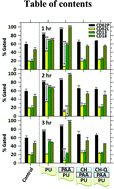Hemocompatibility of chitosan/poly(acrylic acid) grafted polyurethane tubing†
Abstract
The activation and adhesion of platelets or whole blood exposed to chitosan (CH) grafted surfaces is used to evaluate the hemocompatibility of biomaterials. The biomaterial surfaces are polyurethane (PU) tubes grafted with an inner poly(acrylic acid) (PAA) and an outer CH or quaternary ammonium modified CH (CH-Q) brush. The CH, CH-Q and PAA grafted layers were characterized by ellipsometry and fluorescence microscopy. Material wear tests demonstrate that CH (CH-Q) is stably grafted onto PU tubes upon exposure to saline solution for 7 days. Using quartz-crystal microbalances with dissipation (QCM-D), in situ adsorption of blood plasma proteins on CH and CH-Q compared to a silicon oxide control was measured. The QCM-D results showed that the physically adsorbed plasma protein layer on CH-Q and CH surfaces is softer and more viscous than the protein layer on the SiO2 surface. The CH-Q layer thus has the weakest interaction with plasma proteins. Whole blood and platelet adhesion was reduced by ∼92% on CH-Q, which showed the weakest interaction with plasma protein but more viscous adsorbed plasma protein layer, compared to SiO2. Last, to examine the biologic response of platelets and neutrophils to biomaterial surfaces, CH (CH-Q)/PAA, PAA and PU tubes were tested using a Chandler Loop apparatus as an ex vivo model and flow cytometry. The blood adhesion and biologic response results showed that CH and CH-Q reduced adhesion and activation of platelets and neutrophils and improved hemocompatibility relative to other surfaces (PU and PAA). Our studies demonstrated that the properties of physically adsorbed plasma protein layer on biomaterial surfaces correlates with blood coagulation on biomaterial surfaces.


 Please wait while we load your content...
Please wait while we load your content...